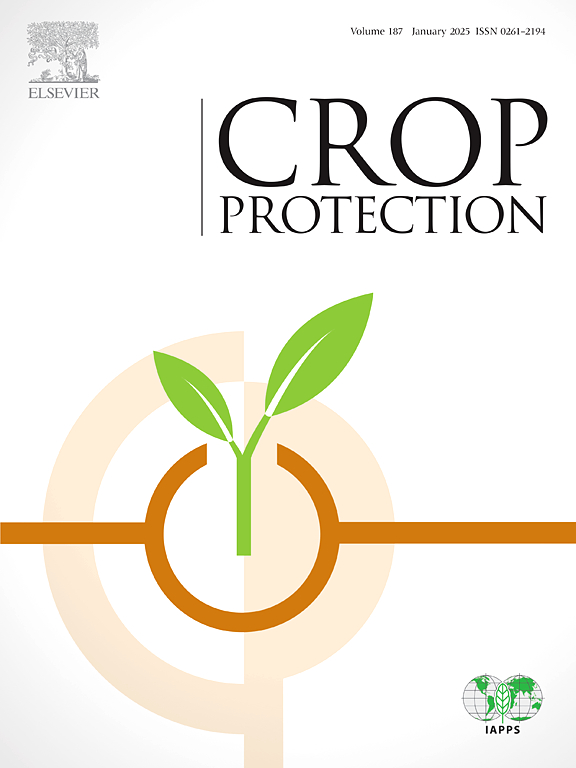浙江省蔬菜作物烟粉虱种群抗药性现状及媒介潜力
IF 2.5
2区 农林科学
Q1 AGRONOMY
引用次数: 0
摘要
甘薯粉虱(Gennadius, 1889)(半翅目:粉虱科)是一种具有重要经济意义的全球性多食性害虫。这种害虫不仅通过吸食植物韧皮部汁液造成直接危害,而且还传播病毒和分泌蜜露,导致黑烟霉的形成,从而加剧了其在农业地区的重要性。虽然化学杀虫剂已被广泛用于控制粉虱,但抗药性的发展导致控制失败的情况经常有记录。在这里,我们通过八个不同地点的温室试验,初步评估了四种常用杀虫剂(啶虫脒、亚砜、螺虫、氰虫)对白蝇种群的功效。此外,我们对35个田间种群进行了全面的分子筛选,以确定杀虫剂靶点的抗性突变并检测植物病原病毒。结果表明,亚砜和氰虫腈对粉虱若虫期的防效最高,而啶虫脒对成虫期的防效最高。乙酰胆碱酯酶(F331W)、电压门控钠通道(VGSC;M918L、L925I、T929V)和乙酰辅酶a羧化酶(A2083V)在土耳其烟粉虱种群中广泛存在。此外,在烟粉虱的VGSC中首次发现了两个先前与拟除虫菊酯类杀虫剂抗性相关的突变I936V和I936F。相反,在ryanodine和烟碱乙酰胆碱受体扩增片段中未检测到氨基酸取代。此外,在安塔利亚的5个大田群体中检测到番茄褪绿病毒(ToCV)。具有多种抗性突变的白蝇种群的广泛分布强调了在土耳其蔬菜生产区实施综合虫害管理计划的必要性。本文章由计算机程序翻译,如有差异,请以英文原文为准。
Insecticide resistance status and vector potential of Bemisia tabaci populations on vegetable crops in Türkiye
The sweet potato whitefly Bemisia tabaci (Gennadius, 1889) (Hemiptera: Aleyrodidae), is an economically important polyphagous pest species with a global distribution. This pest not only causes direct damage by sucking plant phloem sap but also transmits viruses and excretes honeydew, which can lead to the formation of black sooty mould, thereby intensifying its significance in agricultural regions. Although chemical insecticides have been extensively used for whitefly control, the development of resistance leading to control failures has been frequently documented. Here, we have initially assessed the efficacy of four commonly used insecticides (acetamiprid, sulfoxaflor, spirotetramat, cyantraniliprole) against whitefly populations through greenhouse trials across eight distinct locations. Additionally, we conducted a comprehensive molecular screening of 35 field populations to identify resistance mutations at the insecticide target sites and to detect plant pathogenic viruses. The results revealed that sulfoxaflor and cyantraniliprole exhibited the highest efficacy against nymphal stages of whiteflies, whereas acetamiprid was determined to be the most effective insecticide against adult stages. Several well-known target-site mutations in acetylcholinesterase (F331W), voltage-gated sodium channel (VGSC; M918L, L925I, T929V), and acetyl-CoA carboxylase (A2083V) were found to be widespread in Turkish B. tabaci populations. Additionally, two mutations, I936V and I936F, previously associated with pyrethroid resistance, were identified for the first time in the VGSC of B. tabaci. Conversely, no amino acid substitutions were detected in the amplified fragments of the ryanodine and nicotinic acetylcholine receptors. Furthermore, tomato chlorosis virus (ToCV) was detected in five field populations from Antalya. The widespread distribution of whitefly populations with multiple resistance mutations underscores the necessity of implementing integrated pest management programs in Turkish vegetable production areas.
求助全文
通过发布文献求助,成功后即可免费获取论文全文。
去求助
来源期刊

Crop Protection
农林科学-农艺学
CiteScore
6.10
自引率
3.60%
发文量
200
审稿时长
29 days
期刊介绍:
The Editors of Crop Protection especially welcome papers describing an interdisciplinary approach showing how different control strategies can be integrated into practical pest management programs, covering high and low input agricultural systems worldwide. Crop Protection particularly emphasizes the practical aspects of control in the field and for protected crops, and includes work which may lead in the near future to more effective control. The journal does not duplicate the many existing excellent biological science journals, which deal mainly with the more fundamental aspects of plant pathology, applied zoology and weed science. Crop Protection covers all practical aspects of pest, disease and weed control, including the following topics:
-Abiotic damage-
Agronomic control methods-
Assessment of pest and disease damage-
Molecular methods for the detection and assessment of pests and diseases-
Biological control-
Biorational pesticides-
Control of animal pests of world crops-
Control of diseases of crop plants caused by microorganisms-
Control of weeds and integrated management-
Economic considerations-
Effects of plant growth regulators-
Environmental benefits of reduced pesticide use-
Environmental effects of pesticides-
Epidemiology of pests and diseases in relation to control-
GM Crops, and genetic engineering applications-
Importance and control of postharvest crop losses-
Integrated control-
Interrelationships and compatibility among different control strategies-
Invasive species as they relate to implications for crop protection-
Pesticide application methods-
Pest management-
Phytobiomes for pest and disease control-
Resistance management-
Sampling and monitoring schemes for diseases, nematodes, pests and weeds.
 求助内容:
求助内容: 应助结果提醒方式:
应助结果提醒方式:


